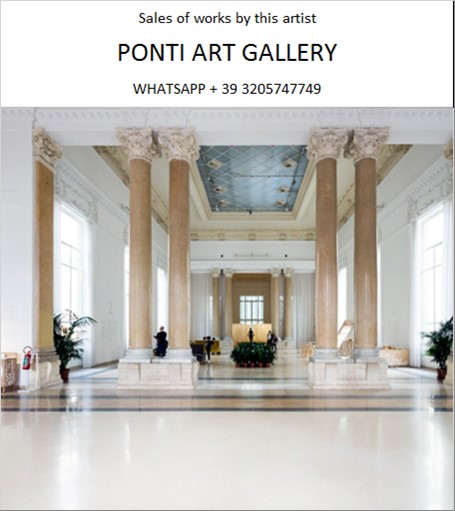Ponti Art Gallery is interested in buying and selling works
of art by this artist.

Victor Vasarely Biography
Victor Vasarely, born Győző Vásárhelyi on April 9, 1906, in Pécs, Hungary, was a visionary artist who played a pivotal role in the development of the Op Art movement. His work, characterized by its innovative use of geometric shapes and optical illusions, has left an indelible mark on the world of modern art.
Vasarely's early life was marked by a strong interest in science, which initially led him to pursue medical studies at the University of Budapest in 1925. However, his passion for art prevailed, and after two years, he abandoned his medical pursuits to focus on painting. He enrolled at the Podolini-Volkmann Academy in Budapest, where he received traditional academic training in the arts. During this time, Vasarely also frequented the bohemian coffee houses of the Danube, where he was exposed to the intellectual and artistic discussions that would shape his creative vision.
In 1929, Vasarely's artistic journey took a significant turn when he enrolled at the Műhely Academy, also known as the Budapest Bauhaus. Under the tutelage of Sándor Bortnyik, Vasarely was introduced to the functionalist principles of the Bauhaus, which emphasized the integration of art and technology. This experience profoundly influenced his approach to art, leading him to explore the potential of geometric abstraction and optical effects.
In 1930, Vasarely moved to Paris, a city teeming with artistic innovation. He initially supported himself as a commercial artist, creating logos, ads, and posters. This period of graphic design work honed his skills in pattern and form, laying the groundwork for his later artistic achievements. Vasarely's first significant exhibition took place in 1930 at the Kovacs Akos Gallery in Budapest, and by the 1940s, he had begun to gain recognition for his unique use of geometric patterns and optical illusions, which he referred to as "kinetic visuality."
Vasarely's breakthrough into abstract art came after World War II, influenced by his experiences at Breton Beach of Belle Isle. He concluded that "internal geometry" could be seen beneath the surface of the entire world, leading him to transpose forms from nature into purely abstract elements in his paintings. His work during this period was characterized by a focus on pattern, repetition, and the creation of optical illusions of depth and movement.
The 1950s and 1960s marked the height of Vasarely's career, as he began using brighter, more vibrant colors to enhance the suggestion of movement through optical illusion. His work from this period, including notable pieces such as "Sirius II," "Ondho," and "Arny-C," exemplified his mature style. In 1955, Vasarely published his "Yellow Manifesto," which laid out the principles of his new aesthetic, "kineticism," and argued that art should be based on scientific principles and aim to create a sense of movement rather than simply reproducing the visible world.
Vasarely's influence extended beyond the Op Art movement, as he bridged the gap between fine art and commercial design, believing that art should be accessible to the masses. His exploration of the relationship between art and technology prefigured the digital age's fascination with visual design and technology. Vasarely's forward-thinking approach resonated with contemporary artists and paved the way for new forms of artistic expression.
In 1970, Vasarely established the Vasarely Foundation, which in 1976 took up quarters near Aix-en-Provence in a building that he designed. The foundation and its museums in Gordes and Aix-en-Provence, as well as in his hometown of Pécs and in Budapest, are dedicated to preserving and promoting his artistic legacy.
Victor Vasarely passed away on March 15, 1997, in Paris, at the age of 90. His legacy continues to inspire and captivate audiences across a wide range of fields, and his work remains a testament to his enduring relevance and appeal. Vasarely's contributions to the field of Op Art have been widely recognized, and his artwork has been featured on postage stamps in both Hungary and France, two countries that played significant roles in his life and career. His vision of a social art, integrated into the urban environment and accessible to all, remains a powerful influence on contemporary art and design.
Victor Vasarely Quotes and
Sales of Works
Ponti Art Gallery selects and deals with paintings by the
artist. Upon request, we provide free estimates and
evaluations, communicate prices, quotations, and current
market values.
If you are interested in BUYING or SELLING works by the
artist, contact us immediately.
If you wish to sell or receive an evaluation of the
works:
Send us a frontal photo of the painting, one of the back,
and one of the signature. Also, indicate the dimensions of
the work. Inform us about the purchase origin of the work
and any kind of available documentation (purchase
receipts, certificates of authenticity, publications). One
of our operators will respond to you on the same day. We
guarantee maximum confidentiality and extreme
professionalism.
If you wish to purchase works by the painter: Contact us
and let us know your request. We will inform you about the
available works. We also offer the possibility to
subscribe to our NEWSLETTER, through which you will be
informed at the beginning of each month about the latest
acquisitions of the art gallery.
You can send us pictures of the work:
